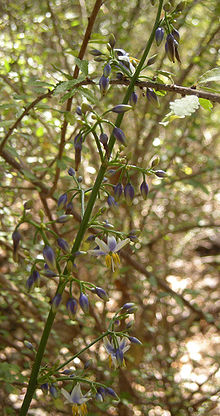- Dianella (plant)
-
Dianella 
Dianella (species unknown) Scientific classification 
Kingdom: Plantae clade: Angiosperms clade: Monocots Order: Asparagales Family: Xanthorrhoeaceae Subfamily: Hemerocallidoideae Genus: Dianella
Lamarck ex. A.L. JussieuType species Dianella ensata
( Thunberg) R.J.F. HendersonSpecies See text.
Dianella is a monocot genus of flowering plants.[1] They are commonly called flax lilies.
In the APG II system of plant classification, Dianella was placed in the family Hemerocallidaceae. When that system was replaced by APG III in 2009, Hemerocallidaceae was combined with two other families to form a larger version of Xanthorrhoeaceae.[2]
Dianella ranges from Japan to India, thence south to Australia and New Zealand; also occurring on many Pacific Islands. About half of the species are native to Australia.[3] Several species are grown for their attractive foliage and shiny, blue to purple berries.[4] Estimates of the number of species range from 20[1] to more than 30.[5] The type species for the genus is Dianella ensata.[6]
Dianella is not well understood taxonomically and is in much need of revision. It is closely related to Thelionema and Herpolirion.[7] Not all taxonomists recognize the genus. In one paper on the classification of Xanthorrhoeaceae, Dianella and six other genera were subsumed in the genus Phormium.
Features:
- Long strappy leaves up to 1 m long
- Range in colour from deep green, blue-green to pale green
- Underground rhizome
- Blue flowers in spring
- Shiny blue to purple berries
- 5mm - 15mm diameter
- Spherical to elongated
- Spongy pulp
- Shiny black seeds
Their habitat ranges from moist forests, dry woodland rainforests and coastal dunes.[8]
Contents
Australian Species (incomplete)
- Dianella bambusifolia, berries reported edible[9]
- Dianella brevicaulis [10]
- Dianella brevipedunculata, leaves to 60 cm, flowers & berries hidden within leaves
- Dianella caerulea, Paroo lily, leaves to 60 cm, flower stem to 90 cm
- Dianella congesta, Beach flax lily, fruit in tight bunches, berries reported edible best tasting [9]
- Dianella longifolia, flower step up to 1m, berries reported edible[9]
- Dianella pavopenacea, berries reported edible[9]
- Dianella rara
- Dianella revoluta, berries reported edible[9]
- Dianella tasmanica, Tasman flax lily, leaves to 80 cm, flower stem to 1.5m, berries not edible[9]
- Dianella tenuissima, recently discovered tussock-forming species from the Blue Mountains of New South Wales
- Dianella amoena
- Dianella tarda
- Dianella poracea
New Zealand Species (incomplete)
- Dianella intermedia, known in Maori as Turutu and painted[1] by the New Zealand artist Emily Cumming Harris
Cultivation
- Frost hardy
- Full sun or part shade
- Propagate by division of rhizome
Uses
Landscaping - some species have dense attractive foliage and eye-catching displays of long-lasting bright blue berries.
Reports of the edibility of the fruit range from very poisonous [11][12] (species not specified) to sweet and nutty [13] (D. caerulea) while another source [9] lists the beach flax lily (D. congesta) as being the best tasting.
The leaves were used to weave dillies and baskets by Australian aboriginals.[9]
-
Dianella (flax lily) & Stylidium graminifolium (grass trigger plant), Cathedral Rock National Park, NSW
References
- ^ a b H. Trevor Clifford, Rodney J.F. Henderson, and John G. Conran. 1998. "Hemerocallidaceae" pages 245-253. In: Klaus Kubitzki (editor). 1998. The Families and Genera of Vascular Plants volume III. Springer-Verlag: Berlin;Heidelberg, Germany. ISBN 978-3-540-64060-8
- ^ Mark W. Chase, James L. Reveal, and Michael F. Fay. "A subfamilial classification for the expanded asparagalean families Amaryllidaceae, Asparagaceae and Xanthorrhoeaceae". Botanical Journal of the Linnean Society 161(2):132–136.
- ^ Starting out with Natives, John Wriggley & Murray Fagg
- ^ Anthony Huxley, Mark Griffiths, and Margot Levy (1992). The New Royal Horticultural Society Dictionary of Gardening. The Macmillan Press,Limited: London. The Stockton Press: New York. ISBN 978-0-333-47494-5 (set).
- ^ Warren L. Wagner, Derral R. Herbst, and Sy H. Sohmer. Manual of the Flowering Plants of Hawaii, Revised Edition, 1999. Bishop Museum Press: Hololulu
- ^ Dianella In: Index Nominum Genericorum. In: Regnum Vegetabile (see External links below).
- ^ Dion S. Devey, Ilia Leitch, Paula J. Rudall, J. Chris Pires, Yohan Pillon, and Mark W. Chase. "Systematics of Xanthorrhoeaceae sensu lato, with an emphasis on Bulbine". Aliso 22(Monocots: Comparative Biology and Evolution):345-351. ISSN 0065-6275.
- ^ What wild flower is that? Alec M Blombery
- ^ a b c d e f g h Wild food plants of Australia, Tim Low
- ^ "Dianella brevicaulis". FloraBase. Department of Environment and Conservation, Government of Western Australia. http://florabase.dec.wa.gov.au/browse/profile/16326.
- ^ http://www.dpi.nsw.gov.au/__data/assets/pdf_file/0008/112796/garden-plants-poisonous-to-people.pdf, page 8
- ^ http://www.alpaca.asn.au/docs/about/husbandry/poison_plants.pdf
- ^ http://www.rbgsyd.nsw.gov.au/plant_info/aboriginal_bush_foods
External links
Categories:- Xanthorrhoeaceae genera
- Hemerocallidoideae
- Long strappy leaves up to 1 m long
Wikimedia Foundation. 2010.



